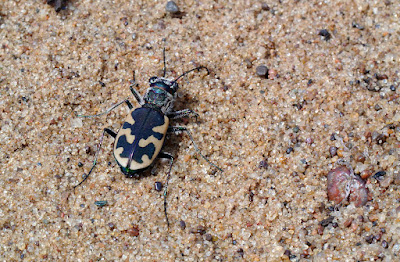"It's spider season. Every year, right about now, thousands of the godless eight-legged bastards emerge from the bowels of hell (or the garden, whichever's nearest) with the sole intention of tormenting humankind."
― Charlie Brooker
Shoreline Wolf Spiders Arctosa littoralis were abundant at the Sauk City Canoe Launch on Saturday, and some were decently sized ― this one about the diameter of a 50-cent piece ...
Aren't they adorable?
These nocturnal hunters thrive in sandy habitats like dunes, beaches, and salt marshes, where their solitary nature and exceptional speed make them formidable predators. Unlike other spiders, Arctosa littoralis doesn't spin a web; instead, it relies on keen eyesight and agility to hunt insects and small invertebrates under the cover of night. These spiders play a crucial role in their ecosystem by helping to control insect populations and serving as a food source for birds, reptiles, and other spiders. However, like many coastal species, Arctosa littoralis faces threats from habitat destruction and pollution.
With the sun behind a cloud, the spider casts almost no shadow, making it even trickier to detect ...
With the ground temperature reaching 60 degrees, there were tiger beetles about the sand as well. Four species were present: Big Sand, Festive, Bronzed, and Oblique-lined, but in small numbers. Again, these are record-early for me ― I've never had this many tiger beetles prior to April.
There was just a single Big Sand Tiger Beetle and I only had one photographic opportunity with it ― I saw it make a few escape flights during my search of the sand. During one pursuit, it retreated to the grass where I finally lost track of it.
Here's a Festive ...
Some side-views ...
And the coveted front-angled view ...
Though non-native, patches of Draba decorated the sandy habitat ― a favorite "little weed" to some!
And it's also time, once again, to start looking for spring ephemeral wildflowers ...
Pasque Flowers aren't as abundant at the Pheasant Branch drumlin this spring, but there were a few open in the late afternoon sun ...
Perhaps it's still early?
But there were signs ...
That perhaps they're past peak ...
Consider how tiny this ant is ...
An annual visit to see and photograph Plasque Flowers at Pheasant Branch is a cherished event for the naturalist. Sometimes they're so numerous they transform the landscape with their vibrant colors and delicate beauty. Walking among them and noticing the quiet diligence of tiny ants pollinating the flowers, this serene scene serves as a poignant reminder of the interconnectedness of all living things and the importance of every creature, no matter how small, in the delicate balance of the ecosystem.
And just a tidbit about aves this weekend ...
Sayornis phoebes have returned to the Pheasant Branch Creek Corridor. For me, their arrival marks a significant moment in the avian cycle of season migration. Their distinctive fee-bee calls announce the arrival of a more committed spring ― they are insectivores. Their return from wintering grounds not only signifies the onset of warmer weather but also promises an abundance of insect life, which they eagerly hunt on the wing.
Pheasant Branch & Middleton Area
March 30th, 2024
47 Species
Anser canadensis
Aix sponsa
Anas platyrhynchos
Anas crecca
Aythya collaris
Bucephala albeola
Meleagris gallopavo
Podilymbus podiceps
Columba livia
Zenaida macroura
Antigone canadensis
Charadrius vociferus
Larus delawarensis
Cathartes aura
Accipiter cooperii
Haliaeetus leucocephalus
Buteo jamaicensis
Melanerpes carolinus
Picoides pubescens
Picoides villosus
Colaptes auratus
Falco sparverius
Falco columbarius
Sayornis phoebe
Cyanocitta cristata
Corvus brachyrhynchos
Poecile atricapillus
Baeolophus bicolor
Eremophila alpestris
Regulus satrapa
Sitta carolinensis
Troglodytes hiemalis
Sturnus vulgaris
Sialia sialis
Turdus migratorius
Passer domesticus
Haemorhous mexicanus
Spinus tristis
Passerella iliaca
Junco hyemalis
Zonotrichia albicollis
Melospiza melodia
Sturnella magna
Agelaius phoeniceus
Molothrus ater
Quiscalus quiscula
Cardinalis cardinalis
All images © 2024 Mike McDowell

















